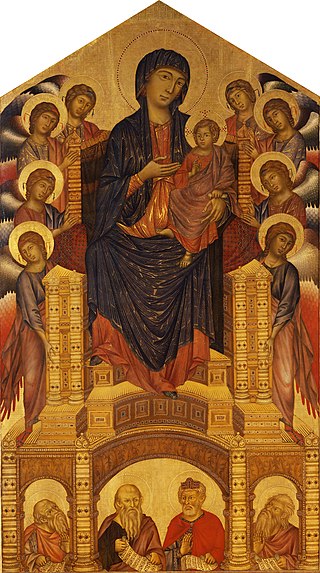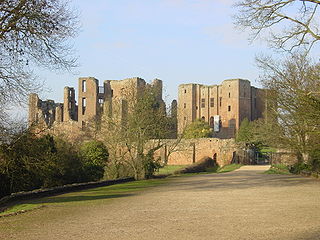Related Research Articles

Cimabue, also known as Cenni di Pepo or Cenni di Pepi, was an Italian painter and designer of mosaics from Florence.

The Dictum of Kenilworth, issued on 31 October 1266, was a pronouncement designed to reconcile the rebels of the Second Barons' War with the royal government of England. After the baronial victory at the Battle of Lewes in 1264, Simon de Montfort took control of royal government, but at the Battle of Evesham the next year Montfort was killed, and King Henry III restored to power. A group of rebels held out in the stronghold of Kenilworth Castle, however, and their resistance proved difficult to crush.

Pope Clement IV, born Gui Foucois and also known as Guy le Gros, was bishop of Le Puy (1257–1260), archbishop of Narbonne (1259–1261), cardinal of Sabina (1261–1265), and head of the Catholic Church from 5 February 1265 until his death. His election as pope occurred at a conclave held at Perugia that lasted four months while cardinals argued over whether to call in Charles I of Anjou, the youngest brother of Louis IX of France, to carry on the papal war against the Hohenstaufens. Pope Clement was a patron of Thomas Aquinas and of Roger Bacon, encouraging Bacon in the writing of his Opus Majus, which included important treatises on optics and the scientific method.

Roger Bacon, also known by the scholastic accolade Doctor Mirabilis, was a medieval English philosopher and Franciscan friar who placed considerable emphasis on the study of nature through empiricism. In the early modern era, he was regarded as a wizard and particularly famed for the story of his mechanical or necromantic brazen head. He is sometimes credited as one of the earliest European advocates of the modern scientific method, along with his teacher Robert Grosseteste. Bacon applied the empirical method of Ibn al-Haytham (Alhazen) to observations in texts attributed to Aristotle. Bacon discovered the importance of empirical testing when the results he obtained were different from those that would have been predicted by Aristotle.
Year 1465 (MCDLXV) was a common year starting on Tuesday of the Julian calendar.
Year 1252 (MCCLII) was a leap year starting on Monday of the Julian calendar.
Year 1130 (MCXXX) was a common year starting on Wednesday of the Julian calendar.

Year 1307 (MCCCVII) was a common year starting on Sunday of the Julian calendar.
Year 1139 (MCXXXIX) was a common year starting on Sunday of the Julian calendar.
Year 1157 (MCLVII) was a common year starting on Tuesday of the Julian calendar.
Year 1222 (MCCXXII) was a common year starting on Saturday of the Julian calendar.
The 1260s is the decade starting January 1, 1260 and ending December 31, 1269.
Year 1192 (MCXCII) was a leap year starting on Wednesday of the Julian calendar, the 1192nd year of the Common Era (CE) and Anno Domini (AD) designations, the 192nd year of the 2nd millennium, the 92nd year of the 12th century, and the 3rd year of the 1190s decade.
Year 1251 (MCCLI) was a common year starting on Sunday of the Julian calendar.
Year 1177 (MCLXXVII) was a common year starting on Saturday of the Julian calendar.
Year 1186 (MCLXXXVI) was a common year starting on Wednesday of the Julian calendar.

Year 1241 (MCCXLI) was a common year starting on Tuesday of the Julian calendar.

Year 1260 (MCCLX) was a leap year starting on Thursday of the Julian calendar.

Year 1265 (MCCLXV) was a common year starting on Thursday of the Julian calendar.
Events from the 1260s in England.
References
- ↑ Stanislawski, Dan (2015) [1959]. The Individuality of Portugal: A Study in Historical-Political Geography. Austin, TX: University of Texas Press. p. 213. ISBN 9781477305072.
- ↑ Nicol, Donald M. (2010) [1984]. The Despotate of Epiros 1267-1479: A Contribution to the History of Greece in the Middle Ages. Cambridge, London and New York: Cambridge University Press. p. 12. ISBN 9780521261906.
- ↑ Sadler, John (2008). The Second Barons' War: Simon de Montfort and the Battles of Lewes and Evesham. Barnsley, UK: Casemate Publishers. pp. 118–119. ISBN 9781844158317.
- ↑ Santiuste, David (2015). The Hammer of the Scots: Edward I and the Scottish Wars of Independence. Barnsley, UK: Pen and Sword. ISBN 9781473857650.
- ↑ Nedvěd, Martin; Peřinková, Martina (2017). "The City of Ostrava (Czech Republic): a Sustainability Assessment Based on Vitality". In Brebbia, C. A.; Sendra, J. J. (eds.). The Sustainable City XII. Southampton and Boston: Wessex Institute of Technology Press. p. 15. ISBN 9781784662172.
- ↑ Bruin, Tom de (2014). The Great Controversy: The Individual's Struggle Between Good and Evil in the Testaments of the Twelve Patriarchs and in Their Jewish and Christian Contexts. Göttingen, Germany: Vandenhoeck & Ruprecht. p. 14. ISBN 9783525540350.
- ↑ Clegg, Brian (2016). Are Numbers Real?: The Uncanny Relationship of Mathematics and the Physical World. New York: St. Martin's Press. p. 80. ISBN 9781466892965.
- ↑ Newall, Venetia (2013). The Witch Figure: Folklore Essays by a Group of Scholars in England Honouring the 75th Birthday of Katharine M. Briggs. Anthropology and Ethnography. London and New York: Routledge. p. 108. ISBN 9781136551734.
- ↑ Brand, Paul (2003). Kings, Barons and Justices: The Making and Enforcement of Legislation in Thirteenth-Century England. Cambridge and New York: Cambridge University Press. p. 1. ISBN 9781139439077.
- ↑ Streitz, N.; Rizk, A.; Andre, J.; André, J. (1990). "Links and Structures in Hypertext Databases for Law". Hypertext: Concepts, Systems and Applications: Proceedings of the First European Conference on Hypertext, INRIA, France, November 1990. Cambridge and New York: Cambridge University Press. p. 194. ISBN 9780521405171.
- ↑ Symons, Van Jay (2013). Friedman, John Block; Figg, Kristen Mossler (eds.). Trade, Travel, and Exploration in the Middle Ages: An Encyclopedia. New York and London: Routledge. pp. 319–320. ISBN 9781135590949.
- ↑ Iqbal, Muzaffar (2007). Science and Islam. Westport, CN and London: Greenwood Publishing Group. pp. xxxi. ISBN 9780313335761.
- ↑ Melton, J. Gordon (2014). Faiths Across Time: 5,000 Years of Religious History. Vol. II: 500 - 1399 CE. Santa Barbara, CA, Denver, CO and Oxford: ABC-CLIO. p. 855. ISBN 9781610690263.
- ↑ Gemmill, Elizabeth (2013). The Nobility and Ecclesiastical Patronage in Thirteenth-Century England. Woodbridge, UK: Boydell Press. p. 8. ISBN 9781843838128.
- ↑ Jaspert, Nikolas (2019). Queens, Princesses and Mendicants: Close Relations in a European Perspective. Vita Regularis - Ordnungen und Deutungen religiosen Lebens im Mittelalter. Zürich, Switzerland: LIT Verlag Münster. p. 20. ISBN 9783643910929.
- ↑ Thompson, Bard (1996). "10. Painters and Sculptors of the Quattrocento - Giotto and his Times". Humanists and Reformers: A History of the Renaissance and Reformation . Grand Rapids, MI and Cambridge, UK: Wm. B. Eerdmans Publishing. pp. 229. ISBN 9780802863485.
1267 Giotto.
- ↑ Guise, Richard (2011). Two Wheels Over Catalonia: Cycling the Back Roads of North-Eastern Spain. Chichester, UK: Summersdale Publishers Limited. p. 310. ISBN 9780857652850.
- ↑ Marcos Hierro, Ernest (2010). Rogers, Clifford J. (ed.). The Oxford Encyclopedia of Medieval Warfare and Military Technology. Vol. I: Aachen, Siege of - Dyrrachium, Siege and Battle of (1081). Oxford and New York: Oxford University Press. p. 52. ISBN 9780195334036.
- ↑ Shirley, Janet (2016) [1999]. Crusader Syria in the Thirteenth Century: The Rothelin Continuation of the History of William of Tyre with Part of the Eracles or Acre Text. Oxford and New York: Routledge. ISBN 9781351947114.
- ↑ Thomson, Williell R. (1975). Friars in the Cathedral: The First Franciscan Bishops 1226-1261. Toronto: Pontifical Institute of Mediaeval Studies. p. 67. ISBN 9780888440334.
- ↑ Wispelwey, Berend (2011). Biographical Index of the Middle Ages. Munich, Germany: K. G. Saur Verlag. p. 877. ISBN 9783110914160.
- ↑ Jackson, Guida M.; Jackson-Laufer, Guida Myrl (1999). Women Rulers Throughout the Ages: An Illustrated Guide . Santa Barbara, CA, Denver CO and Oxford, UK: ABC-CLIO. pp. 52. ISBN 9781576070918.
1267 Beatrice of provence.
- ↑ Watkins, Basil (2015) [2002]. The Book of Saints: A Comprehensive Biographical Dictionary. London: Bloomsbury Publishing. ISBN 9780567664150.
- ↑ Hone, William (1830). The Every-day Book and Table Book: Or, Everlasting Calendar of Popular Amusements, Sports, Pastimes, Ceremonies, Manners, Customs, and Events, Incident to Each of the Three Hundred and Sixty-five Days, in Past and Present Times; Forming a Complete History of the Year, Months, and Seasons, and a Perpetual Key to the Almanac ... for Daily Use and Diversio. London: J. Haddon. p. 1509.
- ↑ Edbury, Peter W. (1994) [1991]. The Kingdom of Cyprus and the Crusades, 1191-1374. Cambridge and New York: Cambridge University Press. p. 35. ISBN 9780521458375.
- ↑ Horsfield, Thomas Walker (1835). The History, Antiquities, and Topography of the County of Sussex. Sussex and London: Sussex Press, Baxter. p. 3.